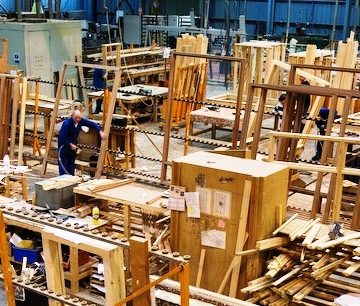Joinery businesses losing thousands through poor waste wood disposal practices
With a ban on landfilling wood waste still possible, the current lack of market data and the prevalence of wasteful procurement practices remain obstacles to timber industry efforts to improve efficiency. On March 28th, a wide range of industry representatives met to tackle the waste issue head on as part of the Timber Resource Efficiency Partnership (TREP).
It was encouraging to see such a wide range of industry stakeholders represented at the event, including attendees from James Lathams plc, Arnold Laver Ltd, Saint Gobain, Defra, the Wood Recyclers Association, BRE, and the BWF. Timber Trade Federation Chief Executive John White chaired the meeting.
A Defra consultation relating to the banning of wood waste to landfill is due this Autumn, so the timber industry will need to ensure that it is one step ahead of the market or the disposal of wood waste could become much more expensive. Although there are a few shining examples of manufacturers making money from waste material, a questionnaire of BWF members in 2009 suggested that wood waste disposal costs range from £200 to £7000 per year with an average of £2100. Assuming a 50% yield rate, this works out as a cost of £125 per cubic metre.
 One of TREP’s objectives is to eliminate the creation of wood waste early on in the supply chain by establishing improved procurement practices. Small and medium sized joinery enterprises produce relatively large amounts of waste from the timber that they buy. This is primarily because they buy whatever timber lengths are available from merchants and then trim it to the lengths they require. Yield levels are usually around 50%, but sometimes as low as 20%.
One of TREP’s objectives is to eliminate the creation of wood waste early on in the supply chain by establishing improved procurement practices. Small and medium sized joinery enterprises produce relatively large amounts of waste from the timber that they buy. This is primarily because they buy whatever timber lengths are available from merchants and then trim it to the lengths they require. Yield levels are usually around 50%, but sometimes as low as 20%.
To help joinery manufacturers improve their efficiency and save money, TREP is helping to develop a merchant range of engineered wood components designed specifically for the woodworking industry and its timber suppliers. The range is currently being consulted on, but will be tailored to suit most casement and sliding sash windows using current glazing and ironmongery systems. It is set to comply with EN standards as recognised across Europe, but will also be specifically suited to UK weather conditions, with the result being that less waste will be generated than by the current trimming of non-standardised sections to the required size.
One of the concerns for companies wishing to dispose of their waste wood in a cost effective way is that the market for waste wood is particularly volatile, and subject to stark regional and seasonal variations, even before you consider the market distorting effect of subsidies for biomass.
Compounding this is the lack of available wood waste data, both within companies and for the broader industry as a whole. BWF Policy Executive, Matt Mahony, who was among the attendees at the TREP meeting, commented:
“Many companies choose to adopt informal methods of waste disposal, so it is often difficult to get reliable market data. Not only does that make it difficult for the market to put a price on wood waste, it also means that it is unlikely for manufacturers to be keeping tabs on the amount of wood waste they produce. A lot of joinery companies could be in for a bit of a surprise when they find out how inefficient they’ve been, both in terms of procurement and disposal.”
In order to help with this, TREP have recently completed the development of a free online tool which provides an easy portal for a company to measure waste (you can use it by clicking here!).
Involvement in a raft of other projects, including regional wood waste collection programmes, means that it will be a busy year for TREP. With the support of the BWF and its membership, the work of TREP should not only boost the credentials of timber as the most sustainable mainstream construction product, but also save the membership time and money.
